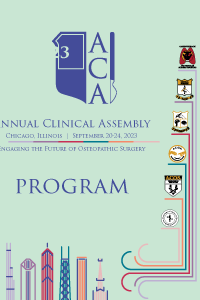General Surgery
Chylous Ascites; 8 Months Status Post Gastric Bypass Surgery
- VC
Victoria Q. Crittenden, OMSII
NOORDA-COM
lehi, Utah, United States
Primary Presenter(s)
Chylous ascites is a rare and diagnostically challenging complication following gastric bypass surgery. We present a case of a patient who developed chylous ascites eight months status post gastric bypass surgery, initially suspected to have acute cholecystitis with possible cholelithiasis. This case report highlights the difficulties in diagnosing and managing this rare condition, emphasizing the importance of a comprehensive laparoscopic exploratory surgery to identify any abnormal findings.
Methods or Case Description:
A 25-year-old female with past medical history significant for gastric bypass surgery 8 months ago in Mexico came to the hospital complaining of abdominal pain that started that morning. The patient reports that she had been doing well until this morning when she started experiencing epigastric abdominal pain that radiates diffusely. The pain began colicky however it progressed to a more constant post-prandial pain that she rates as moderate to severe in intensity. Patient denies alleviating factors, and movement aggravates her pain. She reports experiencing some upper abdominal pain following her gastric bypass and attributed it to her procedure. Recently she has had nausea and post-prandial pain. The patient denies any jaundice, biliuria, or acholic stools. Physical exam is significant for a soft, non-distended abdomen, normal bowel sounds, no masses, no rebound or guarding, with a 2+ tenderness in the right upper quadrant. History of present illness and the physical examination are suspicious for acute cholecystitis with potential cholelithiasis and is recommended to undergo a laparoscopic cholecystectomy. After explaining the diagnosis and recommended procedure the patient would like to proceed with surgery and gave appropriate consent. Upon entering the abdomen, diagnostic findings were significant for a white fluid was found over and around the liver and the gallbladder did not have any remarkable inflammation or signs of cholecystitis. There was a copious white fluid which was thought to be either purulent fluid or chylous ascites. The abdomen, including the pelvis, was carefully explored, where there was no tubo-ovarian abscess or pelvic pathology. The appendix was found to be normal and small bowel was followed until coming across an area that was exuding copious chylous ascites. Further exploration and consultation with a fellow surgeon led us to the conclusion that this was most likely caused by a chronic or not chronic bowel obstruction. The bowel was carefully followed until it was completely untangled from the omentum that was wrapped around the bowel, and adhered to the abdominal wall, and partially obstructing the bowel. The obstructing omentum along with a superior omental piece that was adhered to the abdominal wall were both removed. The obstructing omentum removed appeared to be stuck in a port site from her previous surgery. After further examination without any abnormal gallbladder findings, the cholecystectomy was not preformed. A sample of the chylous acites was sent for a gram stain however it did not return at a reasonable time. Some of the chylous ascites was aspirated out of the pelvis before beginning closing.
Outcomes: Patient underwent exploratory laparotomy and internal herniation was found causing small bowel obstruction. Obstruction was resolved, chylous acites was found and aspirated. The original plan to preform cholecystectomy was not performed due to lack of pathology. Patient is recovered from surgery and has no further complications at this time. Patient was seen 12 days status post laparoscopic exploratory surgery with resolution of small bowl obstruction.
Conclusion:
Chylous ascites, although rare, should be considered in the differential diagnosis of patients presenting with abdominal pain following gastric bypass surgery, even when initial suspicions point towards acute cholecystitis. This case highlights the significance of thorough laparoscopic exploratory surgery to identify and address uncommon complications such as internal herniation. Prompt recognition and appropriate management are crucial in achieving favorable outcomes and symptom resolution. Surgeons should maintain a high index of suspicion for rare postoperative complications, ensuring comprehensive evaluation and tailored interventions for optimal patient care.

